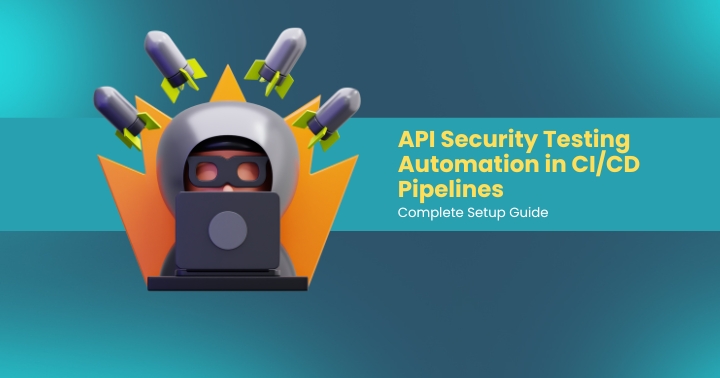APIs drive the world’s digital economy, powering banking platforms, healthcare systems, and enterprise tools. Yet as development speeds up, traditional testing often lags. Manual reviews can’t match the pace of continuous integration and deployment, leaving vulnerabilities undiscovered until it’s too late.
Automated API security testing changes that. It embeds real-time vulnerability scanning into your CI/CD pipelines, ensuring every code push is automatically tested for weaknesses. The result is faster releases without compromising security.
This guide explains how to integrate automated API security testing into your CI/CD environment, select effective tools, design seamless workflows, and measure outcomes using key metrics.
What Is Automated API Security Testing in CI/CD Pipelines
Automated API security testing is the process of continuously checking APIs for vulnerabilities throughout your build and release cycle. Instead of waiting until after deployment, automation tests every change in real time.
Teams with complex microservices benefit from platforms with comprehensive api coverage, ensuring that every new or changed endpoint gets tested before deployment.
How Automation Fits in CI/CD
Automation ensures continuous API testing at developer speed, catching authentication flaws, injection risks, and configuration errors early.
To understand how proactive security aligns with modern DevOps workflows, see our post on Shift Left Security.
Why Manual API Security Testing Fails in Modern Development
Manual penetration testing remains important, but it cannot scale to match modern development velocity. Frequent updates, distributed teams, and microservices architecture demand speed and consistency, something manual testing cannot sustain.
The Limitations of Manual Testing
- Slow Turnaround: Manual reviews delay deployment by days or weeks.
- Scalability Issues: Testing hundreds of APIs manually isn’t feasible.
- Inconsistent Results: Findings depend heavily on the tester's skill and time.
- False Positives: Teams waste effort verifying outdated or low-risk issues.
A Salt Labs study found that 94% of organisations experienced API security incidents in the past year. Most of those could have been prevented with automated testing built into the CI/CD process.
How to Choose the Right API Security Testing Tools for Automation
The effectiveness of your security automation depends on your tool choice. A good platform integrates easily with your existing development ecosystem, provides actionable results, and scales without slowing releases.
What to Look For
Traditional scanners rely on signature-based detection, while AI-powered tools use behavioural analysis to detect logic flaws and zero-day vulnerabilities.
Platforms like APIsec.ai go a step further by simulating real-world attack behaviour across the entire API ecosystem, delivering continuous, intelligent protection.
For a deeper comparison of available tools, see Best API Security Testing Tools.
What Are the Essential Steps to Integrate API Security Testing in CI/CD
Integrating automated security testing into CI/CD isn’t just about adding a tool; it’s about defining a reliable process. Proper setup ensures security remains proactive rather than reactive.
Core Implementation Steps
- Define API Inventory and Risk Levels
- Classify APIs by exposure (internal, public, or partner).
- Assign security gates based on business impact.
- Classify APIs by exposure (internal, public, or partner).
- Set Security Policies
- Decide which vulnerabilities will fail a build automatically.
- Establish thresholds for acceptable risk.
- Decide which vulnerabilities will fail a build automatically.
- Prepare Your Environment
- Use isolated staging environments that mirror production.
- Secure API keys using secrets management within your CI/CD platform.
- Use isolated staging environments that mirror production.
- Run and Validate Scans
- Start with smaller test suites to fine-tune accuracy.
- Compare automated findings with known vulnerabilities for calibration.
- Start with smaller test suites to fine-tune accuracy.
- Expand and Monitor Continuously
- Scale automation to all environments.
- Regularly analyse reports for trends and recurring issues.
- Scale automation to all environments.
To explore implementation models, check our article on API Testing Automation.
How to Configure Automated API Vulnerability Scanning Workflows
Automated workflows should enhance developer productivity, not interrupt it. The key lies in aligning test triggers with your existing CI/CD stages.
Best Practices for Workflow Design
- Shift Left Early: Run key tests during integration, not post-deployment.
- Fail Smart: Block builds only for critical vulnerabilities; issue warnings for low-risk ones.
- Run in Parallel: Execute tests alongside functional checks to save time.
- Use Incremental Scans: Test only modified endpoints to reduce runtime.
Common Trigger Types
For more insights into balancing automation and agility, read DevSecOps and API Security.
What Security Tests Should Run Automatically in Your Pipeline
Automated testing doesn’t mean testing everything all the time; it means testing what matters most, often enough to prevent major risks.
Recommended Automated Tests
- Authentication and Authorisation: Validate JWTs, session tokens, and OAuth scopes.
- Input Validation: Check for injection flaws, malformed data, or unsafe deserialization.
- Data Protection: Verify HTTPS enforcement and encryption configurations.
- Rate Limiting: Ensure proper throttling and DoS prevention.
- Configuration Security: Detect weak headers, open CORS policies, or insecure HTTP methods.
- Logic Testing: Identify abuse of multi-step workflows or bypass sequences.
Test Frequency Strategy
How to Handle API Security Test Failures in Continuous Deployment
Automation is only effective if it can handle failures gracefully. The goal is to maintain deployment velocity while enforcing strong security controls.
Recommended Response Workflow
- Classify Vulnerabilities: Tag each finding as Critical, High, Medium, or Low.
- Fail Fast for Critical Issues: Halt the build if a severe vulnerability is detected.
- Notify in Real Time: Send alerts to teams via Slack, Jira, or email for quick action.
- Allow Warnings for Low Severity: Continue builds with alerts for less critical issues.
- Implement Auto Rollbacks: Revert to the last safe build if production scans reveal new threats.
This model ensures continuous delivery without sacrificing control or safety.
What Metrics Track API Security Testing Effectiveness in CI/CD
To know whether automation is working, you need measurable results. Tracking metrics helps quantify performance and justify investment.
These insights help you refine your DevOps API security process and prove its tangible benefits.
Many organizations look for api security solutions for devsecops integration so that security tests run automatically whenever new code hits the pipeline.
Conclusion
Integrating automated API security testing into your CI/CD pipelines eliminates manual bottlenecks and ensures vulnerabilities are caught early in the development cycle. It allows developers and security teams to collaborate more effectively, maintaining both speed and safety.
For enterprises ready to scale this approach, APIsec.ai offers a fully automated, AI-powered continuous API testing platform that integrates seamlessly with any CI/CD system. It continuously detects, prioritises, and validates vulnerabilities across every build to keep your APIs secure without slowing you down.
FAQs
How long does automated API testing add to CI/CD pipelines?
Typically, only 2–5 minutes per run is far faster than manual testing cycles.
Can automated testing replace manual penetration testing?
No. Automation covers routine vulnerability detection, while manual testing remains essential for logic-based flaws.
What happens when vulnerabilities are detected before deployment?
Critical issues stop the build; non-critical ones proceed with logged warnings for later review.
How can false positives be minimised?
Choose AI-based scanners, fine-tune configurations, and continuously review test rules.
Which CI/CD tools integrate with APIsec.ai?
Jenkins, GitLab, GitHub, Azure DevOps, and CircleCI support APIsec.ai integration through plugins or APIs.
.webp)

.webp)

